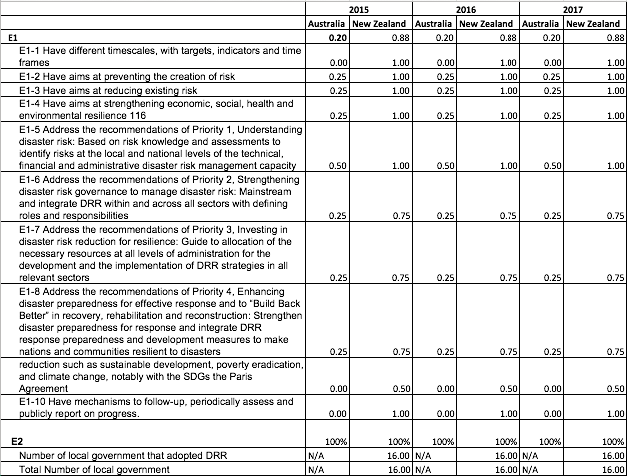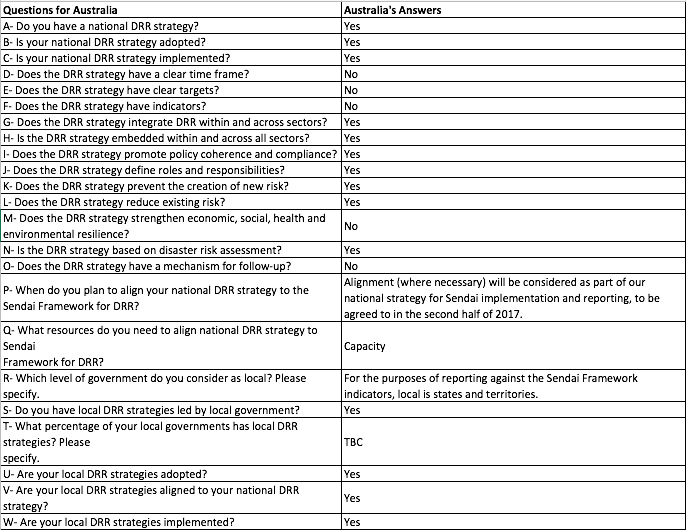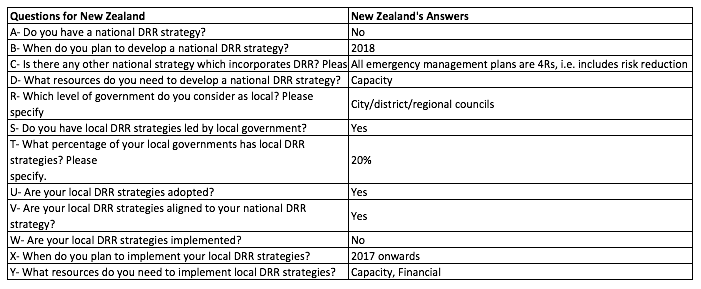Target E from the Sendai Framework is a measure that estimates the number of countries and local actors that have Disaster Risk Reduction (DRR) strategies in place. Its goal is to: “Substantially increase the number of countries with national and local disaster risk reduction strategies by 2020.” However, as it was the case with its predecessor, the Sendai Framework relies on self-assessed scores especially for Target E. Such scores usually include an element of subjectivity which often leads to discrepancies in reporting.
Target E is divided into two indicators E1 and E2; the first assesses national strategies and the second assesses local ones. The indicators are described as follows:
E1: Number of countries that adopt and implement national disaster risk reduction strategies in line with the Sendai Framework for Disaster Risk Reduction 2015-2030.
E2: Percentage of local governments that adopt and implement local disaster risk reduction strategies in line with national strategies. Information should be provided on the appropriate levels of government below the national level with responsibility for disaster risk reduction.
For E2, the UNDRR defines “local government” as any subnational public administration responsible for DRR whether it is a city council, a municipality, or on a district level. The specificity is to be determined by the country itself.
Calculating E1
For E1, countries provide a score of 0 to 1 (with 1 being the highest) to each of the ten sub-indicators enumerated in figure 1. Once all ten sub-indicators have been filled, the total score for E1 is simple summation of the different sub-scores divided by 10 (the number of sub-indicators):
E1’s Ten Sub-Indicators:
- Have different timescales, with targets, indicators and time frames
- Have aims at preventing the creation of risk
- Have aims at reducing existing risk
- Have aims at strengthening economic, social, health and environmental resilience 116
- Address the recommendations of Priority 1, Understanding disaster risk: Based on risk knowledge and assessments to identify risks at the local and national levels of the technical, financial and administrative disaster risk management capacity
- Address the recommendations of Priority 2, Strengthening disaster risk governance to manage disaster risk: Mainstream and integrate DRR within and across all sectors with defining roles and responsibilities
- Address the recommendations of Priority 3, Investing in disaster risk reduction for resilience: Guide to allocation of the necessary resources at all levels of administration for the development and the implementation of DRR strategies in all relevant sectors
- Address the recommendations of Priority 4, Enhancing disaster preparedness for effective response and to “Build Back Better” in recovery, rehabilitation and reconstruction: Strengthen disaster preparedness for response and integrate DRR response preparedness and development measures to make nations and communities resilient to disasters
- Promote policy coherence relevant to disaster risk reduction such as sustainable development, poverty eradication, and climate change, notably with the SDGs the Paris Agreement
- Have mechanisms to follow-up, periodically assess and publicly report on progress.
For each sub-indicator, the country choose a score of 0, 0.25, 0.5, or 1 based on the following rationale:

E2 is simply the percentage of local governments that have engaged in DRR. To calculate it, one must report the total number of local governments that exist within a country and then on the number of DRR-compliant local governments.
Examples: Australia and New Zealand
The following scores have been reported for Australia and New Zealand:


Figure 4 provides a breakdown of these scores:

All of these numbers are based on self-assessment and the monitor does not publish a justification for each of the score a country reports. However, we were able to find the 2017 Sendai Framework Data Readiness Review Report for both countries to help understand the reasoning behind the reported scores.
Data Readiness Report for Australia
Data Readiness Report for New Zealand
Figures 5 and 6 are answers provided by Australia and New Zealand respectively in their data readiness reports. Only questions relevant to Target E are included here:


Questions A to Q specifically relate to E1 and R to Y relate to E2. However, by overlapping the questions from the readiness report to the sub-indicators, one could assume the following the following questions roughly correspond to the following sub-indicators:
D, E, F → E1-1
G, H → E1-6
I → E1-9
J → E1-7
K → E1-2
L → E1-3
M → E1-4
N → E1-5
O → E1-10
P-Y → E2
Analysis and Questions
Matching the question/answer to each of the ten sub-indicators one notices a lot of discrepancies. For instance:
- There is no question related to sub-indicator E1-8
- Since New Zealand answered “No” to the first section but did admit to having an “all emergency plan” that includes risk, we do not have answers to questions B to Q
- It makes sense for Australia to report a score of 0 for E1-1 since it answered “No” to Questions D, E, and F. But how come New Zealand reported a score of 1 on E1-1 when it does not have a national DRR strategy in place?
- Australia reported a score of 0 for E1-9, but answered “Yes” to question I which means that its DRR strategy does promote policy coherence and compliance but not according to the Sustainable Development Goals of the Paris Agreement
- For T, New Zealand reported that only 20% of its local governments have DRR strategies but reported that as a score of 100% on the actual platform.
- Australia reported “TBC” on T which is reflected by a “N/A” score for E2 although Australia did declare that local governments have DRR strategies in place that are adopted, implemented, and aligned to the country’s national DRR strategy.
All in all, as noted by the United Nations International Strategy for Disaster in 2019:
“There is an element of subjectivity in the self-assessment of the national DRR strategies because member states score themselves. However, it is similar to the Hyogo Framework with which member states are familiar, where there was also an element of subjective scoring.”
However, whether or not the scores are objective and reliable, understanding how the scores for Target E are computed will allow us to ask better questions once on the field.

